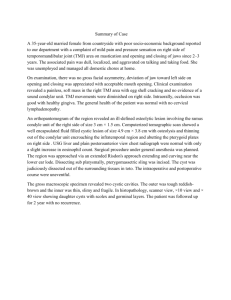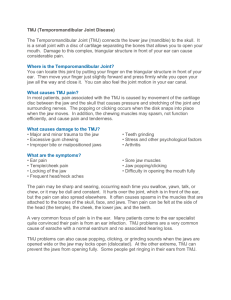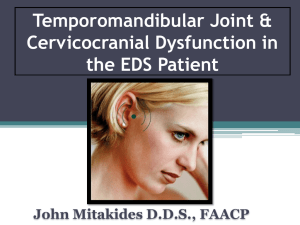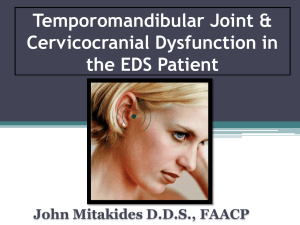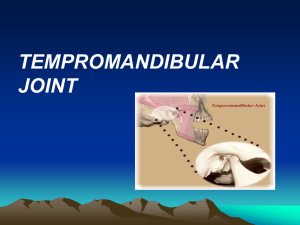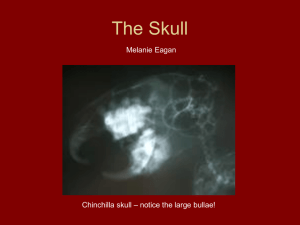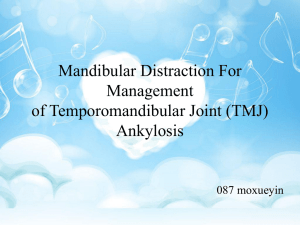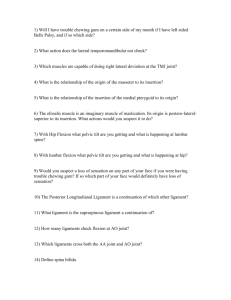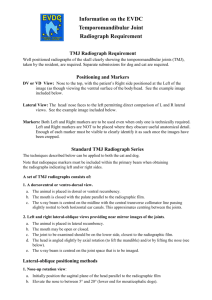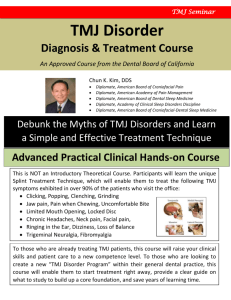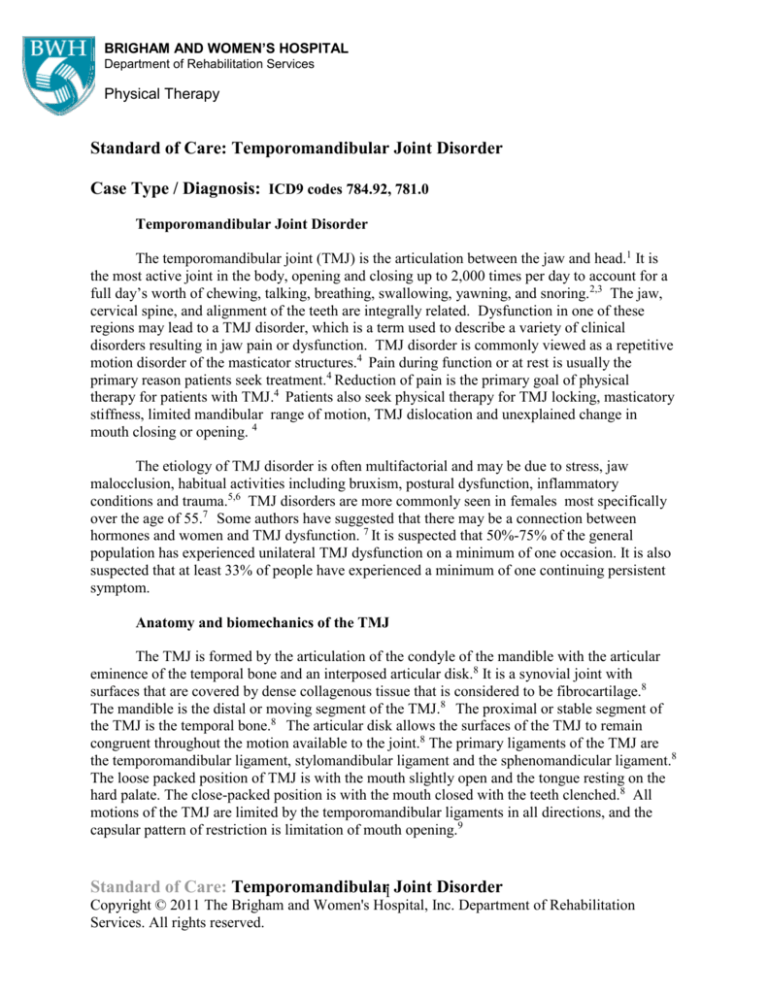
BRIGHAM
BRIGHAMAND
ANDWOMEN’S
WOMEN’SHOSPITAL
HOSPITAL
Department
DepartmentofofRehabilitation
RehabilitationServices
Services
Physical
PhysicalTherapy
Therapy
Standard of Care: Temporomandibular Joint Disorder
Case Type / Diagnosis: ICD9 codes 784.92, 781.0
Temporomandibular Joint Disorder
The temporomandibular joint (TMJ) is the articulation between the jaw and head.1 It is
the most active joint in the body, opening and closing up to 2,000 times per day to account for a
full day’s worth of chewing, talking, breathing, swallowing, yawning, and snoring.2,3 The jaw,
cervical spine, and alignment of the teeth are integrally related. Dysfunction in one of these
regions may lead to a TMJ disorder, which is a term used to describe a variety of clinical
disorders resulting in jaw pain or dysfunction. TMJ disorder is commonly viewed as a repetitive
motion disorder of the masticator structures.4 Pain during function or at rest is usually the
primary reason patients seek treatment.4 Reduction of pain is the primary goal of physical
therapy for patients with TMJ.4 Patients also seek physical therapy for TMJ locking, masticatory
stiffness, limited mandibular range of motion, TMJ dislocation and unexplained change in
mouth closing or opening. 4
The etiology of TMJ disorder is often multifactorial and may be due to stress, jaw
malocclusion, habitual activities including bruxism, postural dysfunction, inflammatory
conditions and trauma.5,6 TMJ disorders are more commonly seen in females most specifically
over the age of 55.7 Some authors have suggested that there may be a connection between
hormones and women and TMJ dysfunction. 7 It is suspected that 50%-75% of the general
population has experienced unilateral TMJ dysfunction on a minimum of one occasion. It is also
suspected that at least 33% of people have experienced a minimum of one continuing persistent
symptom.
Anatomy and biomechanics of the TMJ
The TMJ is formed by the articulation of the condyle of the mandible with the articular
eminence of the temporal bone and an interposed articular disk.8 It is a synovial joint with
surfaces that are covered by dense collagenous tissue that is considered to be fibrocartilage.8
The mandible is the distal or moving segment of the TMJ.8 The proximal or stable segment of
the TMJ is the temporal bone.8 The articular disk allows the surfaces of the TMJ to remain
congruent throughout the motion available to the joint.8 The primary ligaments of the TMJ are
the temporomandibular ligament, stylomandibular ligament and the sphenomandicular ligament.8
The loose packed position of TMJ is with the mouth slightly open and the tongue resting on the
hard palate. The close-packed position is with the mouth closed with the teeth clenched.8 All
motions of the TMJ are limited by the temporomandibular ligaments in all directions, and the
capsular pattern of restriction is limitation of mouth opening.9
Standard of Care: Temporomandibular1 Joint Disorder
Copyright © 2011 The Brigham and Women's Hospital, Inc. Department of Rehabilitation
Services. All rights reserved.
The joint articulation of the TMJ consists of two joint spaces divided by the disk. The
lower joint of the TMJ is a hinge joint formed by the anterior surface of the condyle of the
mandible and the inferior surface of the articular disk. The upper joint of the TMJ is a gliding
joint formed by the articular eminence of the temporal bone and the superior surface of the
articular disk. The disk provides three advantages to the TMJ: increased congruence of the joint
surfaces, the shape of the disk allows it to conform to the articular surfaces, and self centers itself
on the condyle.8
The motions available to the TMJ include mouth opening/mandibular depression, mouth
elevation/mandibular elevation, jutting the chin forward/ mandibular protrusion, sliding the teeth
backwards/ mandibular retrusion and sliding the teeth to either side/ lateral deviation of the
mandible.8 Mandibular elevation and depression occurs in two sequential phases of rotation and
gliding. Mandibular protrusion and retrusion occurs when all points of the mandible move
forward at the same amount. This motion is pure translation and occurs in the upper joint alone.
During mandibular lateral deviation, one condyle spins around a vertical axis while the other
condyle translates forward.8
The TMJ is one of the most frequently used joints in the body. Most of the TMJ motions
are empty mouth movements, which occur with no resistance from food or contact between the
upper and lower teeth. The associated musculature is designed to provide power and intricate
control.8
Muscle
Digastric
Medial pterygoid
Lateral pteryogid
Temporalis
Masseter
Action 1, 8
Primary muscle for mandibular depression
Mandibular elevation; Assists in protrusion
Mandibular depression
Mandibular elevation
Mandibular protrusion
The TMJ and most of the muscles of mastication are innervated by the mandibular branch
of the trigeminal nerve, (cranial nerve V [CN V]). Pain may be referred to adjacent areas on the
face in the distribution of CN V.3
The cervical spine and TMJ are connected via muscular attachments. Muscles that attach
to the mandible also have attachments to the hyoid bone, cranium and clavicle. These muscles
can act upon the mandible, atlanto-occipital joint or the cervical spine. Position of the head and
neck can also affect tension of the muscles and therefore affect the position or function of the
mandible. It is important to remember to examine the cervical spine in conjunction with the
TMJ due to these muscular connections.8
Standard of Care: Temporomandibular2 Joint Disorder
Copyright © 2011 The Brigham and Women's Hospital, Inc. Department of Rehabilitation
Services. All rights reserved.
Pathology
Basic pathologies of the TMJ involve inflammation and degeneration in arthritic
disorders and structural aberrations in growth disorders. Overall, the etiology of the most
common types of TMJ disorders is complex and still largely unresolved.12 This list below
includes some of the main agreed upon categories of TMJ disorders10:
a) Arthritic: Characterized mainly by pain. As the disease progresses symptoms can
lead to internal derangement and facial deformity.10 Painful crepitus or grating
sounds is common in patients with TMJ osteoarthritis.12 Treatment is aimed at
controlling risk factors and inflammatory response.10
b) Growth disorders: Characterized mainly by facial deformity. Treatment is aimed
at removing the tumor and correcting the deformity 10
c) Non-arthritic disorders: Characterized mainly by mechanical derangement, which
can include luxation and acute (traumatic) disc dislocation.10 Myofascial pain and
dysfunction are present due to a primary muscle disorder resulting from oral
function habits. Some of the habits can be related to headache, chronic back pain,
irritable bowel syndrome, stress, anxiety and depression.12 Internal derangement
refers to a problem with the articular disc with an abnormal position leading to
mechanics interference and restriction of mandibular activity.12 A patient who
presents with internal joint derangement will have continuous pain that will be
exacerbated by jaw movement. Clicking and locking will result in restricted
mandibular opening or deviation of mandibular movements during opening and
closing.12 Treatment is aimed at reducing the mechanical obstruction.10
In 2010 authors Stedenga et al developed a categorization for TMJ disorder that focuses
on intra-articular positional changes of the disc (internal derangement). The authors noted that
these internal derangements can explain most of the mechanical manifestations occurring in the
joint.10 This newer classification system seems to further describe the “non arthritic disorders”
listed in the list noted above.
a) Disc derangements, which explains clicking sounds and movement restriction
because of the obstruction of condylar movement by the disc 10
b) Subluxation and luxation of the disc-condyle complex, which represents TMJ
hypermobility disorders10
c) Adherence, adhesion, and ankylosis of joint surfaces, which results in TMJ
hypomobility10
Indications for Treatment:
1.
2.
3.
4.
5.
Pain
Clicking, crepitus or popping
Decreased ROM in mouth opening
Locking of the jaw with mouth opening
Difficulty with functional activities of the TMJ: chewing, talking, yawning
Standard of Care: Temporomandibular3 Joint Disorder
Copyright © 2011 The Brigham and Women's Hospital, Inc. Department of Rehabilitation
Services. All rights reserved.
Contraindications / Precautions for Treatment:
Post-operative patients may have surgeon specific precautions regarding physical therapy
progression. Contact the surgeon, as appropriate, to clarify case-specific precautions.
Evaluation:
Medical History: Review computerized longitudinal medical record (LMR), review of
systems and intake health screening tool.
History of Present Illness: Note course of symptoms and presence of trauma (MVA,
assault), previous surgery (dental implants, ORIF), and/or repetitive trauma (see habitual
activities below).
Signs and symptoms of TMJ dysfunction are often unilateral but can be bilateral.
Clicking may or may not be present at the time of the evaluation. Note any history of
clicking and locking. Note current or past use of mouth orthotics or splints, the results
and the reason the patient stopped using the appliance, if applicable. Also inquire about
nocturnal symptoms and daytime symptoms.4 A patient may wake up with TMJ pain
which lasts for only minutes to hours, which suggest the nocturnal factors are the primary
contributors to the symptoms. Other patients awake symptom free and the TMJ
symptoms develop later in the day, suggesting that daytime factors are the primary
contributors.4 Some patients may have pain during the night and daytime, so both of
these symptoms producers need to be considered. 4 Typically patient may have more
pain in the morning and sore teeth due to clenching. There is often a history of stress and
difficulty in sleeping.12
Social History: Note daily habitual activities such as smoking, bruxism (clenching),
chewing gum, snoring, leaning on chin, biting nails, lip biting, clenching teeth, etc. can
all contribute to the presenting symptoms. Consider work, household responsibilities,
hobbies and/or recreational activities that may involve repetitive stress and sustained
postures, e.g. computer work. Emotional stress can trigger nervous habits or poor
postural responses, which can lead to TMJ symptoms.3
Medications: Note relevant medications including NSAIDS, muscle relaxants, and other
analgesics. Some patients may be taking Amitriptyline, Nortriptyline, or Diazepam
before bedtime to reduce EMG activity at the TMJ.4
Diagnostic Imaging: Plain film radiography is the gold standard to evaluate the TMJ.
A/P and lateral views are used to assess the normal shape and contours of the condyles5,
the position of the condylar heads in open and closed mouth positions and to measure the
amount of movement available.5 Periapical images can exclude problems with the
teeth.6 Magnetic resonance imaging (MRI) can be used to assess the disk position and
Standard of Care: Temporomandibular4 Joint Disorder
Copyright © 2011 The Brigham and Women's Hospital, Inc. Department of Rehabilitation
Services. All rights reserved.
shape and is used primarily when a nonreducing disk is suspected clinically. Since disk
displacement is common in assymptomatic subjects, MRI evidence of disk displacement
is not considered significant unless ROM is restricted or a nonreducing disk is suspected
clinically.6 Computed tomography (CT) and arthroscopy have been advocated but
ordering these tests should be at the discretion of the specialist oral and maxillofacial
surgeons.12
Examination
This section is intended to capture the most commonly used assessment tools for this case type/diagnosis. It
is not intended to be either inclusive or exclusive of assessment tools.
Observation:
Opening and closing of mouth: Inspect that the teeth normally close
symmetrically and that the jaw is normally centered.
Alignment of teeth: Take note of a cross bite, under or over bite. Identify any
missing teeth.17
Symmetry of facial structures (eyes, nose, mouth): Note of any facial
deformity which can range from very subtle to severe and readily visible
deformation.10 Examine both soft tissue and bony contours between left and
right halves.17 Pay special attention to muscular paralysis, such as ptosis of the
eyelid or drooping of the mouth, which may be associated with Bells Palsy.17
Also determine whether the upper and lower lip frenulums are properly
aligned.17
Posture: Note the presence of forward head posture, rounded shoulders and
scapular protraction.18 Also be aware of scoliosis or cervical torticollis, which
affect the length tension relationships of the muscles attaching to both sides of
the mandible causing an uneven pull to one side.18
Breathing pattern: Assess if diaphragmatic breathing occurs or if there is an
accessory pattern to breathing.
Tongue: Examine for presence of bite marks, scalloping (tongue resting
between teeth) resulting from tongue not properly resting on the hard palate or
from tongue being excessively wide. A dry or white appearance of the tongue
is an abnormality and may indicate bacterial infections, dysfunction of
salivary glands or adverse reaction to medications.17
Pain:
The main complaint may include orofacial pain, joint noises, restricted mouth
opening or a combination of these.12 It is helpful to evaluate pain in terms of
onset, nature, intensity, site, duration and aggravating and relieving factors. Also
consider how the pain relates to features such as joint noise and restricted
mandibular movement.12 Determine which movements cause pain, including
opening or closing of mouth, eating, yawning, biting, chewing, swallowing,
speaking, or shouting. The patient may also present with headaches and cervical
pain. Pain may also be present in the distribution of one of the three branches of
the trigeminal nerve (CN V).11 Pain is generally located with the masseter
muscle, preauricular area, and anterior temporalis muscle regions. The pain is
Standard of Care: Temporomandibular5 Joint Disorder
Copyright © 2011 The Brigham and Women's Hospital, Inc. Department of Rehabilitation
Services. All rights reserved.
usually an ache, pressure, or a dull pain which may include a background burning
sensation. There may also be episodes of sharp pain and throbbing pain. This pain
can be intensified by stress, clenching and eating. Pain may be relieved by
relaxing, applying heat to the painful area or taking over the counter analgesics.4
TMJ disorders are distinguished from other possible diseases by the
location of pain. TMJ pain is specifically centered in and around the preauricular
region and may be accompanied by clicking or grating sounds with mandibular
function and restricted mouth opening.12
Cervical spine and upper quadrant screen:
Assess cervical and shoulder A/PROM, muscle length including deep cervical
flexors, myotomes, dermatomes and reflexes.
Palpation:
TMJ: Palpate the TMJ bilaterally while the patient opens and closes the mouth
several times.18 Assess for joint integrity and structural deviations. The
mandibular condyles on both sides should move smoothly and equally.18 If the
examiner feels one side rotate before the other or shift laterally while the
mandible is moving, this may indicate TMJ dysfunction.18
Muscles of mastication: Palpate and compare bilaterally, assess for pain
and/or muscle spasm
o Some of the muscle to be palpated can include: lateral pterygoid
(intraorally), insertion of temporalis (intraorally), medial pterygoid
(externally), masseter (externally) 12
o It is recommended that the masseter, anterior temporalis and TMJs be
palpated to ensure that it intensifies or reproduces the patient’s pain in
order to determine the primary source of pain.4 These areas can be
palpated by having the patient clench the jaw and palpating the muscle
over its origin and muscle belly.18Areas of tenderness, trigger points
and patterns of pain referrals should be noted.12 Joint sounds and their
location during opening, closing and lateral excursion may be palpated
or detected with a stethoscope placed over the preauricular area.12
ROM:
AROM: Range of motion can be measured from top tooth edge to bottom tooth
edge marking on a tongue depressor and measuring the distance in millimeters.18
Opening and closing of mouth
Normal opening = 35-50 mm3
Functional opening = 25-35 mm or at least two knuckles between teeth3
Protrusion of mandible
Normal = 5 mm3
Lateral deviation of mandible
Normal = 8-10 mm3
Standard of Care: Temporomandibular6 Joint Disorder
Copyright © 2011 The Brigham and Women's Hospital, Inc. Department of Rehabilitation
Services. All rights reserved.
Note asymmetrical movements, snapping, clicking, popping or jumps.
Mechanical derangements account for the common clinical signs of clicking
and locking.10
Record deviations: lateral movements with return to midline
Record deflections: lateral movements without return to midline
PROM: Apply overpressure at the end range of AROM to assess end feel
Strength:
Deep cervical flexors and scapular stabilizers should be assessed. Refer to a
manual muscle testing (MMT) text such as Daniels and Worthingham’s
Muscle Testing20 or Kendell and Kendell21 for complete description of MMT
techniques.
Resisted opening, closing, lateral deviations and protrusion of the jaw should
also be tested. Upon testing, the patient should have the mouth open one to
two centimeters and therapist should place a stabilizing hand on the
forehead.18 A gradual onset of force should be used so that the patient can
resist the motion appropriately.18 Pain and/or weakness with the resisted
testing are positive findings.18
Sensation:
Assess upper quadrant dermatomes, C1, C2, C3, cutaneous nerve supply of the
face, scalp and neck, cranial nerves V – XII.3
Joint sounds:
Crepitation: A sound that is continuous over a long period of time of jaw
movement, like grating or grinding.7
Clicking: A distinct, very brief sound with a clear beginning and end. 7
Joint mobility:
Caudal traction, ventral glide (protrusion), medial/lateral glide. Refer to joint
mobilization texts for appropriate techniques, e.g. Edmond9, Maitland13
Dynamic loading7:
Load contralateral TMJ - bite on cotton roll.
Compression of bilateral TMJ – Grasp the mandible bilaterally and tip the
mandible down and back to compress the joints.
Distraction of bilateral TMJ – Grasp the mandible bilaterally, distract both
joints at the same time.
A positive finding to dynamic loading is pain.
Functional Activities:
Assess chewing, swallowing, coughing, and talking. Either have patient
demonstrate task or ask for patient’s subjective report. Include changes the
patient has made to their own diet to accommodate for their pain and dysfunction.
Standard of Care: Temporomandibular7 Joint Disorder
Copyright © 2011 The Brigham and Women's Hospital, Inc. Department of Rehabilitation
Services. All rights reserved.
Differential Diagnosis:
Approximately 70% of patients presenting with TMJ disorders also have cervical
spine impairments according to Rocobado.19 It is important to screen the cervical spine
and upper quadrant as part of the TMJ evaluation.
Non-musculoskeletal disorders may also cause facial and jaw pain including
infection, dental problems including malocclusion, trigeminal neuralgia, parotid gland
disorder, or other lesions of the face, mouth or jaw. If non-musculoskeletal origin of pain
is suspected, refer to the primary care physician for further work-up.
Patients who present with TMJ pain may also have symptoms related to tooth
pain. Tooth related pain includes: pain that occurs or intensifies upon drinking hot or cold
beverages, throbbing pain that occurs spontaneously, throbbing pain that awakens the
patient from sleep. If these symptoms are present, a referral to a Dentist would be
appropriate.4
Patients with TMJ disorder may also report a feeling of fullness of the ear,
tinnitus and/or vague dizziness. These symptoms are seen in approximately 33-40% of
patients with TMJ dysfunction and usually resolve after treatment.11
Assessment:
Establish Diagnosis and Need for Skilled Services
Often patients with TMJ dysfunction present with pain, forward head posture, protracted
shoulders, mouth and accessory muscle breathing patterns, abnormal resting position of the
tongue and mandible, and abnormal swallowing mechanism. Patients with these clinical signs
will benefit from skilled physical therapy intervention to correct these upper quarter muscle
imbalances and to restore the normal biomechanics and motor control of the TMJ.19
Problem List:
Potential Impairments:
Increased pain
Limited A/PROM
Impaired posture
Impaired motor control/strength
Decreased knowledge of habit modification, relaxation techniques
Potential Functional limitations:
Inability to chew, cough, sneeze, swallow or talk without pain
Standard of Care: Temporomandibular8 Joint Disorder
Copyright © 2011 The Brigham and Women's Hospital, Inc. Department of Rehabilitation
Services. All rights reserved.
Prognosis:
Medlicott and Harris published a systematic review in Physical Therapy July
2006, analyzing 30 research studies that tested the effectiveness of various physical
therapy interventions for temporomandibular joint disorder.14 The authors conclusions
and recommendations are as follows:
1. Active exercises and joint mobilizations, either alone or in combination, may be
helpful for mouth opening in patients with acute disk displacement, acute arthritis, or
acute or chronic myofascial pain.14
2. Postural training may be used as an adjunct to other treatment techniques as it’s
effectiveness alone is not known.14
3. The inclusion of relaxation techniques, biofeedback, EMG training, proprioception
education may be more effective than placebo or occlusal splints in decreasing pain
and mouth opening in patients with acute or chronic myofascial pain.14
4. A combination of active exercises, manual therapy, postural training, and relaxation
training may decrease pain and increase mouth opening in patients with acute disk
displacement, acute arthritis, or acute myofascial pain. It is not known, however, if
combination therapy is more effective than providing a single treatment
intervention.14
A study by Kurita et al explored the natural course of symptoms for patients with
internal disk displacement without reduction over a 2.5 year period.15 They found that
approximately 40% of patients were asymptomatic at the end of the study period, 33% of
patients had a reduction in symptoms and 25% of patients did not improve. These
figures, which show a wide range of results, were similar to another study looking at TMJ
outcomes over a one-year time frame and were not dependent on splinting treatment.16
Some studies suggest that patients with TMJ with cervical or widespread pain
will not obtain the same degree of improvement as other patients with TMJ who do not
have these pains. 4
Goals
Short term (2-4 wks) and long term (6-8 wks) goals may include but are not limited to:
1. Reduce or independently self manage pain symptoms or joint noises
2. Normal ROM and sequence of jaw movements
3. Maximize strength and normalize motor control of muscles of mastication,
cervical spine and periscapular region
4. Maximize flexibility in related muscles as indicated
5. Maximize postural correction in sitting and/or standing
6. Correct ergonomic set-up of workstations at home and/or at work
7. Independence with home exercise program
8. Independence with relaxation techniques
Standard of Care: Temporomandibular9 Joint Disorder
Copyright © 2011 The Brigham and Women's Hospital, Inc. Department of Rehabilitation
Services. All rights reserved.
Age Specific Considerations
Younger women 20-40 years of age are most likely to report TMJ disorder
symptoms. Adolescents and elderly men are least likely to report TMJ dysfunction.7
Treatment Planning / Interventions
Established Pathway
___ Yes, see attached.
_X_ No
Established Protocol
___ Yes, see attached.
_X_ No
Interventions most commonly used for this case type/diagnosis.
This section is intended to capture the most commonly used interventions for this case type/diagnosis. It is
not intended to be either inclusive or exclusive of appropriate interventions.
Non-surgical treatments such as counseling, pharmacotherapy and occlusal splint therapy
continue to be the most effective way of managing over 80% of patients. 12
Treatment strategies may include but are not limited to:
Modalities for pain control: Heat, ice, electrical stimulation, TENS, ultrasound,
phonophoresis
A/AA/PROM
Stretching: active, assisted and passive stretching, can use tongue depressors or cork
as needed. Refer to physical therapy texts for specific techniques.
Joint mobilization or manipulation: Restore normal joint mechanics of the TMJ,
cervical and/or thoracic spine as appropriate. Refer to appropriate texts for treatment
techniques.9,19, 21
Soft tissue mobilization, myofascial release and deep friction massage
Muscle energy techniques
Neuromuscular facilitation: hold-relax, contract-relax, alternating isometrics. For
specific exercises refer to physical therapy references e.g. Hertling and Kessler’s
Management of Common Musculoskeletal Disorders.19
Relaxation techniques: learning to relax masticatory muscles and maintain this
relaxed state during the day; learning stress management and coping skills4
Biofeedback and EMG training to promote muscle control and relaxation 4
Therapeutic exercises: Including Rocobado 6 x 6 isometrics program.22 Cervical
stability exercises.
Frequency & Duration:
The frequency and duration of follow up treatment sessions will be individualized based
on the specific impairments and functional limitations with which the patient presents
during the initial evaluation. On average, the frequency may range from 1-2 times per
week for 4-6 weeks.
Standard of Care: Temporomandibular10Joint Disorder
Copyright © 2011 The Brigham and Women's Hospital, Inc. Department of Rehabilitation
Services. All rights reserved.
Patient / family education:
To stop or change poor habits including grinding or clenching teeth. An over-thecounter mouthguard or an occlusal orthotic from the Dentist may be helpful for
nighttime use.4 The occlusal orthotic can be helpful for masticatory muscle pain,
TMJ pain, TMJ noises, restricted jaw mobility, and TMJ dislocation.4
Postural re-education and maintenance correct resting position of the tongue and
mandible
Diaphragmatic breathing
Body mechanics training
Home exercise program instruction
Recommendations and referrals to other providers.
Speech and Language Pathologist for assessment and treatment of speech or
swallowing dysfunction associated with the TMJ dysfunction
Rheumatologist
Psychologist/Psychiatrist
If conservative measures do not alleviate the patient’s symptoms, surgical
management may be considered. Surgical interventions may include dental implants,
condylectomy, condylotomy, ORIF or surgical manipulation. It is beyond the scope
of this standard to discuss the specifics of the above listed procedures. Potential
surgical referrals could include:
1. Otolaryngologist (ENT)
2. Dentist or oral surgeon
3. Orthopedic surgeon
Re-evaluation / assessment
Reassessment should be completed every thirty days in the outpatient setting unless
warranted sooner. Possible triggers for an earlier reassessment include a significant change in
status or symptoms, new trauma, plateau in progress and/or failure to respond to therapy.
Discharge Planning
Commonly expected outcomes at discharge:
Resolution or independent management of pain symptoms
Functional, active motion of mandible
Resume normal functional activities with jaw, including chewing and talking
Modifications of parafunctional or habitual activities that are associated with the
cause of the patient’s TMJ dysfunction
Ability to self-correct and maintain normal postural alignment of the head, neck and
trunk
Correct ergonomic set up of workspace
Independent home exercise program and self progression of program
Standard of Care: Temporomandibular11Joint Disorder
Copyright © 2011 The Brigham and Women's Hospital, Inc. Department of Rehabilitation
Services. All rights reserved.
Patient’s discharge instructions
Home exercise program
Relaxation techniques
Habit modification
Authors:
Karen Weber, PT
June, 2007
Updated:
Alyssa Weber, PT
November, 2011
Reviewed by:
Joel Fallano, PT
Amy Butler, PT
Janice McInnes, PT
Reviewed by:
Ken Shannon, PT
Lina Penikas Lamb, PT
Standard of Care: Temporomandibular12Joint Disorder
Copyright © 2011 The Brigham and Women's Hospital, Inc. Department of Rehabilitation
Services. All rights reserved.
REFERENCES
1. Helland, M. Anatomy and Function of the Temporomandibular Joint. JOSPT: 1980.
2. Hoppenfeld S. Physical Examination of the Cervical Spine and Temporomandibular Joint. In:
Physical Examination of the Spine and Extremities. Norwalk, CT: Appleton and Lange.1976.
105-132.
3. Magee DJ. Temporomandibular Joint. In: Orthopedic Physical Assessment, Magee ed.
Philadelphia: WB Saunders Co, 1999, 152-174.
4. Wright, E and North, S. Management and Treatment of Temporomandibular Disorders: A
Clinical Perspective. J Man Manip Ther. 2009;17(4): 247-254.
5. Sommer OJ et al. Cross-sectional and functional imaging of the temporomandibular joint:
Radiology, pathology, and basic biomechanics of the jaw. Radiographics online. 2003; 23:
e14.
6. Sheon1 RP. Temporomandibular joint dysfunction syndrome. UpToDate. 2006.
7. Reneker, J et. al. Diagnostic Accuracy of clinical Tests and Signs of Temporomandibular
Joint Disorders: A Systematic Review of the Literature. JOSPT. 2011; 41(6): 408-416.
8. Levangie, P. and Norkin, C. Joint Structure and Function A Comprehansive Anaylsis, 3rd
edition. Philadelphia: FA Davis. 2001.
9. Edmond SL. Temporomandibular Joint. In: Manipulation and Mobilization: Extremity and
Spinal Techniques. 1993: Boston, Mosby. 203-210.
10. Stegenga, B. Nomenclature and classification of temporomandibular joint disorders. Journal
of Oral Rehabiliation. 2010; 37: 760-765.
11. Hedge V. A review of the disorders of the temperomandibular joint. JIPS: 2005; 5(2): 5661.
12. Dimitroulis, G. Fortnightly review: Temporomandibular disorders: a clinical update. British
Medical Journal. 1998; 317(7125): 190-194.
13. Maitland. Peripheral Mobilization and Manipulation
14. Medlicott MS, Harris SR A systematic review of the effectiveness of exercise, manual
therapy, electrotherapy, relaxation training, and biofeedback in the management of
temporomandibular disorder. Phys Ther 2006: 86(7): 955-973
15. Kurita K et al. Natural course of untreated symptomatic temporomandibular joint disc
displacement without reduction. J Dent Res 1998: 77(2): 361-365.
16. Lundh H et al. Temporomandibular joint disc displacement without reduction. Treatment
with flat occlusal splint versus no treatment. Oral Surg Oral Med Oral Pathol, 1992; 73: 655658.
17. Palmer, L. Fundamentals of musculoskeletal assessment techniques. 1998.
18. Sailors, M. Evaluation of Sports- Related Temporomandibular Dysfunctions. Journal of
Atheltic Training. 1996:31(4); 346-350.
19. Hertling D. The Temporomandibular Joint. In: Management of Common Musculoskeletal
Disorders: Physical Therapy Principles and Methods, 3rd edition. Darlene Hertling and
Randolph M Kessler, eds. New York: Lippincott, 1996: 444-488.
20. Daniels and Worthingham’s Muscle Testing: Techinques of Manual Examination, 6th
Edition. Helen J Hislop and Jacqueline Montgomery eds. Philadelphia: WB Saunders Co,
1995.
Standard of Care: Temporomandibular13Joint Disorder
Copyright © 2011 The Brigham and Women's Hospital, Inc. Department of Rehabilitation
Services. All rights reserved.
21. Kendall FP, McCreary EK, Provance PG. Facial, Eye, and Neck Muscles; Muscles of
Deglutition; and Respiratory Muscles. In: Muscles Testing and Function. John P Bulter,
editor. Philadelphia: Williams and Wilkins (1993), 299-330.
22. Temporo-Mandibular Joint Complex Exercise Suggestions. Available at:
http://itandb.com/pdf/TMJExercises.pdf. Accessed October 14, 2011.
Standard of Care: Temporomandibular14Joint Disorder
Copyright © 2011 The Brigham and Women's Hospital, Inc. Department of Rehabilitation
Services. All rights reserved.

